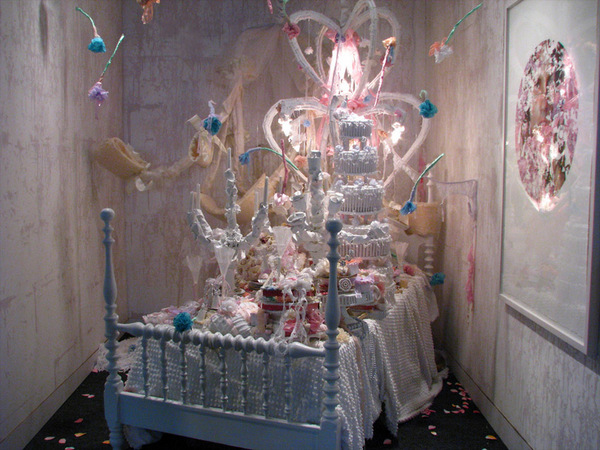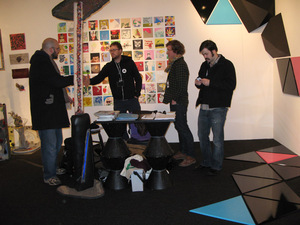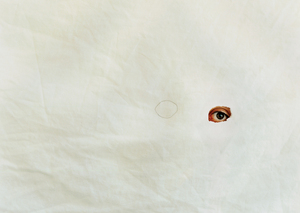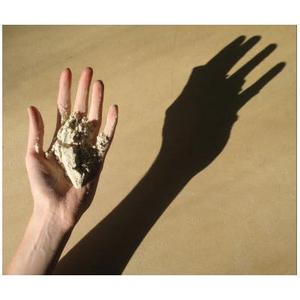This is an archive of the ArtCat Zine, 2007-2009. Please visit our new project, IDIOM.
Recently by Julie Fishkin
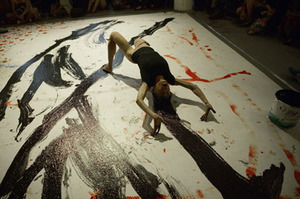
The International Studio & Curatorial program, a former warehouse wedged conveniently in East Williamsburg next to an egg factory and a few fungus-like new condos, is the perfect place to serve as host to visiting artists and curators. Not too big, the space has only a few galleries open to the public while the rest of thie building is home to studios for international artists in residency for the year. Inviting and manageable, this charming space held an intimate evening of performances by artists who incorporate music into their work, or did so at least for Hear Myself In It an evening of music set against the current exhibition up at ISCP titled On the Tectonics of History.
I used to think of Pulse as the hip, younger cousin to the Armory, the one who you feel weird about admitting any familial relations. Now I think it's more like the rich aunt: very kind, generous, always perfectly put together, but a bit cold and aloof. In no way is this a judgment on the art or the presented projects but just a general overview of the scene. In fact, as far as art viewing and the constraints of space go, Pulse does not disappoint. Nearly every booth is straight up curated and perfectly contained, using just the right wall-space-to-art-work ratio, while presenting works on paper, canvases, photographs, installations, video, and even performance. Much like the general air of a slightly defeated, somewhat despondent, but mostly just optimistically reinvigorated air of New York City in the wake of our oft-discussed economic gutter, creative energy abounds. Gallerists are friendlier, perhaps knowing that while uber-success may not be in the cards, exposure and zealous curiosity is still the underpinning that draws the bulk of the spectating hordes. Don't get me wrong: tight-faced, bedazzled ladies still make their appearance but perhaps less so at Pulse this year.
DCKT Contemporary's presents a meticulously curated show of work by Cordy Ryman -- whose small abstract paintings, sculptures and installations use a variety of material to poke fun at the contrivances of visual language while exploring the nuances of "artistic" versus everyday material. Prague's Vernon Galerie shows a very complicated project by Jakub Nepras that, while intensely gripping, was too complicated for my short attention span. The gallery brought an impressive array of work. Like an Olympic triumph, Pulse victoriously passes the torch by showcasing galleries from distant lands, including notables Chi-Wen Gallery from Taipei, Space from Bratislava, Habana from Havana City and Silver Lens Gallery from Manila. Adding to the fun are the numerous installations, as part of the Pulse Installations series, for which individuals artists were commissioned to do a slew of diverse work, in case viewing art in contained booths is simply not your thing. Clifton Childree's hilarious abandoned tropical shack titled Miamuh Swamp Adventure, is a dilapidated construction that viewers enter to find a slapstick silent film about Miami real estate scams from the turn of the century -- a perfect piece during which to take a break, check your email or make out. Laure Prouvost's Close your eyes, you are the only one is a sound piece that serenades you with spam and chain mail. Miriam Cabessa meanwhile spent hours painting her performance piece Slow Motion Action Painting, which admittedly lacked in action but delivered on the "slow."
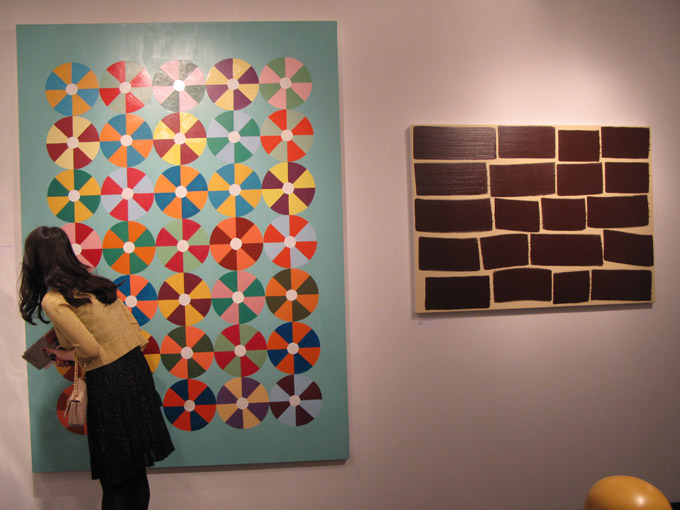
I can still remember the glorious days of yore (2004) when Scope was held at the not-yet-opened-but-with-a-pool Gansevoort Hotel. as the Meatpacking was quickly becoming the glorious "bridge and tunnel" cesspool, coinciding with Samantha Jones' move to the neighborhood and its quick and structural demise.The dark and swanky hotel rooms, the copious Kettle One everwhere and those frozen tubes of neon corn syrup they peddle in the local bodegas -- except this time melted and intended for use as mixers: it's a memory of sensation. Alas, Scope has changed -- neigh, revolutionized, in many ways. The air of disorganized merriment notwithstanding, the fair is now a whole new animal.
Tightly wedged between Fordham Law and Lincoln Center, Scope's highbrow neighbors are an apt consortium for the fair's presence. Scope now fills a chorus line of tents that give way before giving way to a harmonious range of galleries, individual artist projects and other sundry exhibitors. A number of notable galleries quickly draw you into their strongholds, either with great art or free wine. Let's face it, a great and timeless match that I can and will not refuse. (Huevos rancheros?) Glass and camera in hand, I immediately noticed the charming folks of Okay Mountain, an artist run gallery from Austin. Exhibiting their own collective work as well as other artists from the gallery, they had a visual cornucopia of sculpture, digital prints, works on paper, various large multi-media pieces and a friendly disposition. Further along and part of the special artists' projects that the Scope Foundation has commissioned is Comenius Roethlisberger and Admir Jahic's Without You Babe, There Ain't No Us, originally shown at Scope Miami just a few months prior. A series of works on paper utterly preoccupied with YouTube, Without You Babe... offers an antidote to the tendancy for art as a pixelated screen grab. The artists render their obsessively over-watched favorite moments with the soft markings of colored pencils, streaming online pop culture videos into simple, contemplative scenes.

I first came across the Shopdropping project in 2004 when I saw a big wall of re-configured cans stacked in perfect disarray across a wall in a big group show. Alongside were photographs of said cans in grocery stories, infusing the boring aisles with images of meat lockers, Belgian cobble stone streets, Ferris wheels and other photographs that artist Ryan Watkins-Hughes chose for each can. I eventually learned that his ongoing project is more than just adorning these cans; it's an action whose antecedents one could trace back to Situationist legacy, in line with a history of integrating art into life and creating social chaos that disturbs the inertia of an environment driven by commerce and consumption. Over the past few years, I even had the chance to to do a few "shopdrops" with Watkins-Hughes. Once in Providence, we were accused of corporate espionage, replete with threats and insults, followed by a prompt expulsion from the store. About a year ago Watkins-Hughes was profiled in the New York Times for his activities here. In April, he'll turn New York's Heist Gallery into a veritable bodega, changing the context and reception of his project, and possibly bringing it to its appropriate conclusion. -J.F.
Julie Fishkin: You've been doing the shopdropping project for quite a while now. Do you still see it as a form of social/corporate chaos?
Ryan Watkins-Hughes: I've been working on shopdropping in some form or another since 2003 or 2004? And while I'm consistently working on other projects, shopdropping seems to resonate and continue to offer new challenges to explore. My tendency is actually to be a little all over the place artistically, so it has been healthy to have one thing to come back to over the years. The key, I think, has been to keep developing the concept and to take it in new directions. The show at Heist Gallery in April will be a chance to flip the whole thing upside down. It'll be crucial to change the initial point of reference for the audience or it won't work in a gallery.
As far as creating social havoc, I'm much more interested in visual chaos and the breakdown of a "sensible" visual environment than any attempt at targeted social change. I have very little interest in creating an overt and direct critique of packaged culture and the consumer system. I'd rather create graphic mayhem within an environment that is usually so mundane. I wholly appreciate it when the unexpected, purely for its own sake, is introduced into a system that is incapable of dealing with it. It may be as simple as that. There are other "shopdropping" projects floating around that are far more politically specific, and I respect their directness, but I am more interested in fucking with the customs of visual language than in spreading a message of anti-consumerism. It's understandable to get worked up about sweat shops, mega chain stores, endless advertising, etc; but I think there are better ways to change these things than by starting an art project.
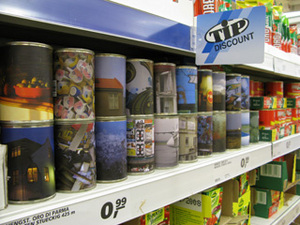
JF: You're living in New Orleans these days. That's a pretty rough place in some patches. Can you really speak about "rendering food items useless" with a clear conscience, you bourgie elitist. I'm just kidding. But seriously.
RWH: New Orleans IS a bit rough these days. But to hear New Orleanians tell it, this town has almost always been like that. The national spotlight just wasn't paying attention. I think the culture here is extremely unique, in that there is a level of freedom that doesn't exist anywhere else in the States. The other side of this, though, is that many people exploit the situation. There is an extremely high level of poverty and drug abuse here. To see that every day on a consistent basis has been an eye opener to the politics of this country over the past decade or so. People really are left to fend for themselves. New Orleans, and its neglect by the federal government since 2005, is a blatant example of this. I grew up in downtown Atlanta in the midst of its yearly competition for the title of "Murder Capital of the US," which teaches a kid a bit of street smarts, but the news here in New Orleans has been worse than anything I've seen in NY or Atlanta. This is a city with rich character and history, but it needs help. The long-time residents of the city are sick of it, and are doing what they can to stop the violence, but I think we need fundamental changes within the city, state, and national government to truly improve the situation. I don't suggest to have any idea what those changes should be, except that a solution certainly won't come in the form of a $300 stimulus check from either major political party.
As far as rendering food items useless with a clear conscience: I think food in our system has already been made pretty useless. Or at least, it has been removed from any sort of thoughtful, conscience part of our day. Most people eat what is cheap and convenient. Corn syrup and fast food. Sugars, sodium, carbs, and empty calories. When I'm busy I live off of canned food and take out. I'm sure my sodium intake right now is dangerously exceeding the recommended daily amount. I guess what I'm trying to say is that we have a surplus of food, and resources in this country to feed our citizens in a healthy and enjoyable way. But we've taken the whole ritual out of the process and many of us choose the hustle and bustle over focusing on the small things and then expect to live off of prepackaged crap.
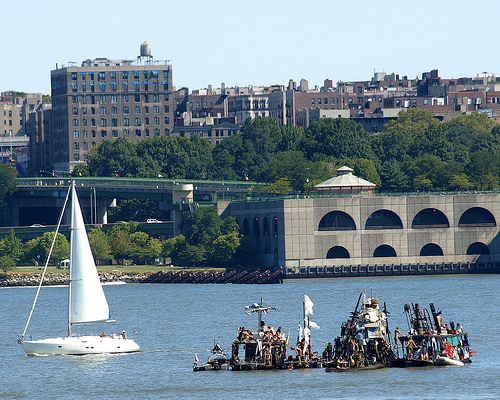
Swimming Cities of Switchback Sea
Deitch Projects, Long Island City - 4-40 44th Drive, Long Island City NY
7 September - 19 October 2008
Watching the seven boats of the Switchback Sea crew pull up at Deitch Studios was spectacular. We waited as a marching band played their punk rock take on songs of wayward ships and seafaring adventures. The impressive constructions were part of a flotilla of seven ships, each one hand made, impeccably decorated with sundry metal parts, junkyard salvaged goods, cardboard cut-outs and a massive dose of enthusiasm from its devoted crew. This first ship that pulled up was the steamboat, a beautiful vintage vessel intricately decorated and engineered by a skilled crew from San Franciso with a gassifyer that burns wood or coffee. Next came the rafts, each fantastically adorned with all salvaged parts, wheat pastes and screen prints, with a motley group of punk pirates who all contributed to the project and lived on the boats for two months.
The Swimming Cities of the Switchback Sea are exactly what the name suggests, veritable city-like vessels that float down the Hudson river as an art project that culminated at Deitch Studios with a play by Lisa D'Amour about the mysteries, whims and creations that a life at sea can reveal. This junkyard caravan carried the crew of artists, musicians, engineers, cooks and lucky groupies in a punk rock summer camp for older kids, mostly in their 20s and 30s, for a dream trip. So taken aback by the visual spectacle of the floticalla, some concerned citizen on the Staten Island Ferry allegedly called the police, thinking, perhaps not so erroneously, that the crew were pirates. There was even a baby on board who took his first step across one of the vessel's decks, walking on water in the most memorable of circumstances. Besides pirate planks, ferris-wheels, chairs, swings, appliances, resounding musical instruments, tattood skinny punk boys with extremely tight pants, feathers, and ornate costumes, Swoon's installation at the gallery was another deftly clever meander through a dark and undgeground city replete with its own characters. Her wheat-pasted, cut out portraits are giant; they loom atop sculptural formations made with discarded furniture, ropes, painted boards and doors and even a gilded corner replete with random items stacked, tied and assembled and then spray painted gold. Together with the seven vessels of the flotilla, Swoon has created a magical place that uses sculpture as a performance space, combining the installation and performance with an accessible platform for other artists to collaborate, musicians to play, playwrights to produce and spectators to watch and partake in the creation as it happens.
Swoon's floating art project might well be a direct descendant of the Miss Rockaway Armada rafts that sailed down the Mississippi river for the past two summers. The Miss Rockaway was largely an idealistic experiment in communal living where crew members dumpster dove for food, lived on the kindness of strangers in every city and town they would visit and made collective decisions on all matters concerning the journey. Each visited town became a carnival of music, artists, free silk-screening workshops, acrobats, dancers, and general festival-like celebrations of life through art. With no set goals of pre-planned destinations, the crew lived at sea for several months, changing and evolving across the way. Switchback Sea, however, was more explicitly an art project; enlisting the help of seventy-five plus volunteers, Swoon realized her vision with a visual cornucopia of crazy elements whose size and marks of craft bear the sign of a love's labor. The Miss Rockaway Armada is currently stationed at the Mass MoCA in North Adams, MA and will be there on view until March 19, 2009. While the future of the Swimming Cities is not confirmed, the crew may head to Venice next year. While these intrepid vessels may not be equipped to cross the Atlantic, perhaps the crew will develop a flying element, adding a whole other dimension to the scope and scale of the project.
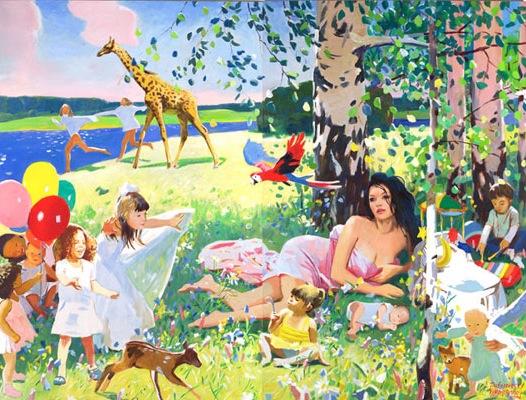
The New People Are Already Here
Vladimir Dubossarsky and Alexander Vinogradov
Deitch Projects - 76 Grand St, New York NY
Russia is a country of many contradictions. The rich live lavishly, adorned with Chanel and BMW SUVs that often come with a driver and a body guard. The poor, on the other hand, live in dire straits because the vestiges of a dead regime following the dissipation of the Soviet Union left them with nothing more than pathetic pensions that are not a far leap from Soviet bread lines and empty shelves in department stores. In fact, according to the Forbes list of the richest men in the world, number three, following Bill Gates and Warren Buffet, is the Russian mogul Roman Abramovich. Fine, he is actually number 11, but at the age of 39, his net worth is $18.2 billion. And yet the tight fists of the neo-dictators, who rule this multifarious and expansive land, seek to rid the country of criminal activity that has been so conducive to the "oligarch" status the wealthy men of business have acquired. The less fortunate masses view former president, now prime minister Putin's Czar-like persona with the same ambivalence that marks this nation; after all, while he has tacitly extinguished any potential opposing voices (read: killed off all the journalists who dare to speak any brazen truth), he has equally quelled the fires of mafia wars that raged in Russia through the 1990s. With business management and democratic politics under their belt, elite Russians have turned to art as the category of knowledge that can buy them a certain level of sophistication. In fact, Sotheby's recently shipped a collection of works to Bavrikha, a high end mall of sorts on the outskirts of Moscow, where the oligarchs buy their Gucci and their Fendi, and now, can browse the de Koonings, Hirsts and Warhols.
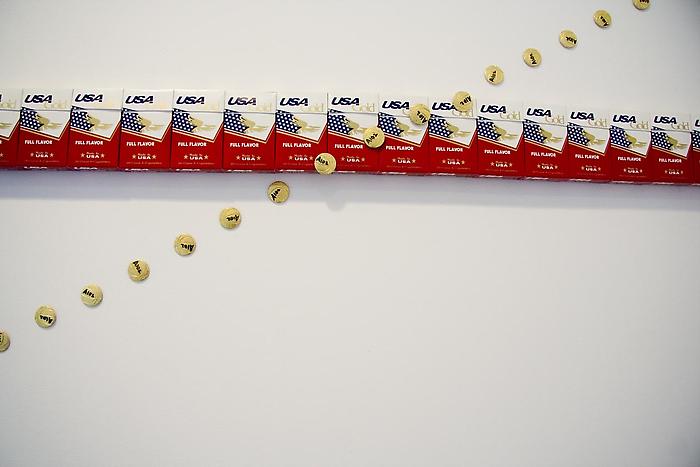
Winning is Not For Everyone
Mike Quinn
Perry Rubenstein Gallery - 534 W 24 St
27 March - 17 May 2008
Obsessions tend to be unhealthy. Though often personal and familiar to the soul, obsessions occupy so much space in one's mind that living with them becomes obvious, even manageable. Over the years, if an obsession does not wane, the best thing to do is focus your creative energy on it, milk its potential for inspiration and use it to your advantage. After all, it's clearly not going anywhere. I've learned to make mine into vital subjects that I can dissect, expound upon, rethink and recreate. If, however, life becomes a heavy burden, overwhelmed by obsessive tendencies in any direction, things can get increasingly complicated. No one is devoid of problems; scope and gravity may vary, but corrosive tendencies are never wholly unfamiliar. Mike Quinn's new solo exhibition at the Perry Rubenstein Gallery, Winning is Not for Everyone is a personal exploration of some of his more somber thoughts, their resolutions, and an obsessive love for basketball.
31 under 31
Curated by Lumi Tan and Jonathan Feinstein
3rd Ward - 195 Morgan Ave Brooklyn NY
1 March - 28 March 2008
If we need a month to commemorate the achievements of women across cultures and generations, then it’s only fitting that an exhibition should sometimes fall under a thematic conception as loose as this month’s dedication. 31 Under 31, currently on view at 3rd Ward, is an exhibition that brings thirty-one women under the age of thirty-one to show one photograph each. Though a vast and expansive criteria and an equally vague thematic structure, curators Lumi Tan and Jonathan Feinstein have selected thirty-one impressive and striking photographs that proudly display the talent and astute vision of thirty-one very different young women. The parameters of sex and age have nothing to do with artistic skill, personal taste or creative vision and yet, when given these basic guidelines under which an artist can showcase her work, the end result is clearly multifarious and wildly eclectic, which lends itself well for photographic interpretations. Because an age group cannot reflect an aesthetic predisposition and because age can only speak about the number of years passed, all the other personal motivations for every photograph presented are as different from the next as each photographer’s background and personal history.
The Size of Thoughts
Julia Weist
295 10th Avenue
7 February - 4 March 2008
Our bodies are defined by certain physical perimeters and constraints. While we can't transgress the material possibilities which constitute those bodies, we often challenge and explore their potential for the sake of pleasure, pain, or even pain for pleasure. When art asks us to position our bodies, that irrefutable mound of mass that we can't shake or change too drastically, in relation to the work at hand, the arising conflict is immediate because no inanimate object could ever be a distinct source of comparable measure to any of our basic faculties. Julia Weist's exhibition, The Size of Thoughts, presents a physical barrier to the work, specifically the glass window that blocks our immediate path to the objects on view. Weist's exhibition at 295 Tenth Avenue, a site curated monthly by Lumi Tan, presents sculptures made of discarded and reconfigured paperbacks and asks us to size up our own material presence in relation to these once narratively inscribed objects (books and images) that are here sculptures intended for distanced inspection and investigation. In this work, thoughts become material objects as the once immaterial narrative form of the novel is turned into shredded pieces of repurposed wood, the basic foundation for the paper upon which these words were printed is reduced to its constituting stuff. The piece, titled Lumber, made from ripped margins of discarded romance novels, is a new take on MDF, an industrial wood reborn as M.D.F, "Made of Discarded Fantasies."
Spectators can only view the exhibition like a peep show in which discarded information becomes the striptease of words and ideas. Weist creates, in effect, naked bodies made of objects that she presents in their physical wholeness for our bodies to size up. Next to the MDF of the M.D.F. we find Weist's other project: a novel about a sexy librarian whose sexual escapades get her two STDs and a novella worth of torrid adventures. The peepshow of the 295 window doesn't reveal any more than the gaze can capture (although you can buy the book and read the narrative yourself). Instead, Weist installs the book in a real MDF frame, placed next to another romance novel — the ultimate of disposable literary genres — this one written by Weist's deceased step-grandmother two years prior. The objects presented force the viewer to face the presence of the stories enclosed in a physical case that precludes any ability to delve into the ideas they would otherwise suggest or communicate. In Weist's work, thoughts can only occupy the physical size of the source material on which they were originally inscribed, the substance that makes their material composition: whether it's a novel about romance or hot sex, or the wood used to frame the book's cover turned it into something we can see but can't touch.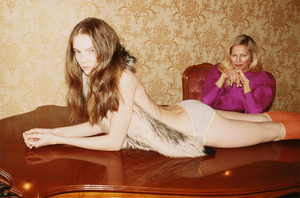
Ukraine
Juergen Teller
Lehmann Maupin Gallery - 540 W. 26 St, New York NY
7 February - 15 March 2008
Arriving at the Juergen Teller opening at Lehmann Maupin last week, I stared in horror at the huge crowd of people clamoring to get inside what seemed — and proved an impeccable assumption — a giant clothing ad disguised as an art exhibition. Luckily the crowd was smarter than I had anticipated. I pushed my way past the greedy looking eyes queuing up for their free Lufthansa sponsored sausage — because everything tastes better when it's free and corporate sponsorships allows one to justify this type of blind consumption. It's funny how popular this show was considering I didn't recognize anybody, despite their coy poses for the photographers who chased all the skinny c-listers with fur trimmed coats. The fur looked like cheap shit rabbit but at least she was tactful enough not to get her sausage bits all over the cases that held the photographs, unlike the other cow whose blatant disregard I secretly admired. Clearly someone decided that a photograph enclosed in what functions like a large table was both a practical and resourceful approach to exhibition strategy. I could not agree more. What was shocking however, was that Marc Jacobs had no hand in the show. If the patron saint of corporate sponsors heard my prayers, he would have sent copious MJ swag — or at least perfume samples. As a Board of Advisors "prime cut" member, even on the Phillips de Pury staff, we got diminutive plastic baggies that came in shiny shades shamrock and olive drab for us lucky female employees to choose from. The made-in-China tag was smaller than the MJ logo so everyone was thrilled. But for Juergen Teller — nothing, not even an appearance!
I airkissed my way to the door, finished my beer, complained about the traffic to the exit being worse than the L train at rush hour, and left with no lasting impressions except for the delightful image of one Ukrainian whore with a Third World boob job and a scar to show that was quite possibly worse than the one on Britney's vagina in that most memorable celebrity photo of 2007. Too bad Juergen didn't shoot that one. It could have been so much more poignant.
ZINE
HOME
TIPS / COMMENTS
CATEGORIES
CONTRIBUTORS
- Greg Afinogenov
- B. Blagojevic
- Adda Birnir
- Susannah Edelbaum
- Julie Fishkin
- Paddy Johnson
- Jessica Loudis
- Christopher Reiger
- Andrew Robinson
- Peter J. Russo
- Blythe Sheldon
- S.C.Squibb
- Hrag Vartanian

